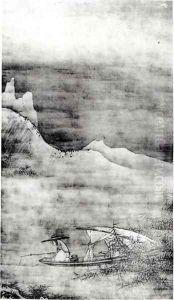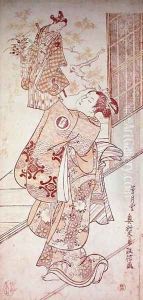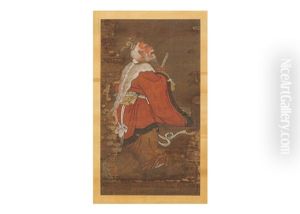Masanobu Kano Paintings
Masanobu Kano (狩野 正信) was a significant Japanese painter of the Kano school, one of the most prestigious and long-lasting schools of Japanese painting. Born in 1625, Masanobu was part of the Kano lineage, which had been influential in the development of Japanese art for centuries, particularly under the patronage of the shogunate and nobility. The school was known for its blending of Chinese influences with native Japanese artistic traditions, a synthesis that Masanobu skillfully carried forward into the Edo period.
Masanobu took on the mantle of leadership within the Kano school at a time when Japan was undergoing profound changes. The Edo period (1603–1868) was marked by relative peace and stability, which allowed the arts to flourish. As the head of the Kano school, Masanobu played a crucial role in catering to the tastes of the ruling samurai class, as well as the imperial court. His works often featured themes from nature, history, and mythology, rendered with a refined elegance that was the hallmark of the Kano aesthetic.
One of Masanobu's significant contributions to Japanese art was his role in the decoration of the Edo Castle, as well as other castles and villas belonging to the Tokugawa shogunate. These commissions were not only a testament to his and the Kano school's artistic excellence but also to their pivotal position in the cultural life of Edo Japan. Masanobu's style was characterized by bold brush strokes and a dynamic use of space, which brought a new vigor to the traditional themes of Japanese painting.
Throughout his career, Masanobu also worked as an educator, training the next generation of painters who would carry the Kano legacy into the future. His teachings emphasized the importance of mastering traditional techniques while also being open to innovation. Masanobu's influence extended beyond his lifetime, as his sons and students continued to dominate Japanese painting, ensuring the Kano school's preeminence well into the 19th century.
Masanobu Kano passed away in 1694, leaving behind a rich legacy of artistic achievement that continues to be celebrated today. His work not only exemplifies the Edo period's artistic sensibilities but also represents a critical link in the evolution of Japanese art, bridging the past with the future. Through his contributions, Masanobu helped to solidify the Kano school's reputation as a cornerstone of Japanese cultural heritage.


